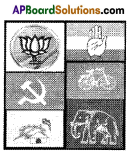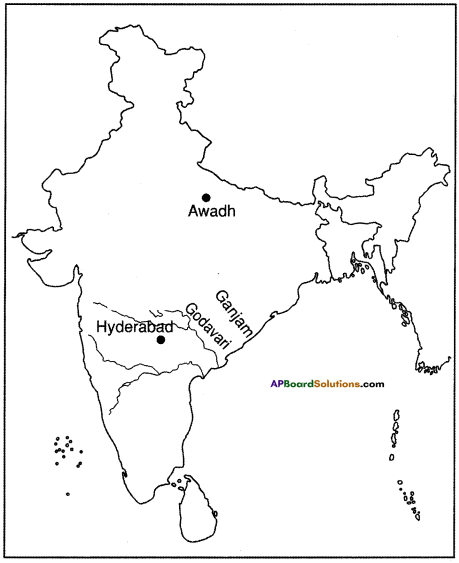SCERT AP Board 8th Class Social Solutions 2nd Lesson Energy from the Sun Textbook Questions and Answers.
AP State Syllabus 8th Class Social Studies Solutions 2nd Lesson Energy from the Sun
8th Class Social Studies 2nd Lesson Energy from the Sun Textbook Questions and Answers

Question 1.
Correct the false statements.
a) If a place is closer to the sea, irrespective of its distance from the equator, it will always be cooler.
Answer:
True
b) As you go up higher from the earth, it becomes warmer because the sun is closer to you.
Answer:
False.
Correction: As you go up higher from the earth, it becomes cooler, because the temperature decreases at the rate of 6°C for every ascent of 1000 metres.
c) Sun heats the air first and then the earth.
Answer:
False.
Correction: Sun heats the earth first and then the air.
d) Global warming is related to oxygen.
Answer:
False.
Correction: Global warming is related to carbon-di-oxide.

Question 2.
What’s the difference between the highest temperatue in Table 2 and the lowest temperature in Table 1?
Table 1
| Month | Maximum°C | Minimum °C |
| Jan | 30 | 17 |
| Feb | 33 | 19 |
| Mar | 37 | 22 |
| Apr | 39 | 26 |
| May | 39 | 26 |
| Jun | 35 | 25 |
| Jul | 33 | 24 |
| Aug | 33 | 24 |
| Sep | 33 | 23 |
| Oct | 32 | 23 |
| Nov | 30 | 20 |
| Dec | 29 | 18 |
Table – 2
| Month | Maximum°C | Minimum °C |
| Jan | 32 | 19 |
| Feb | 32 | 21 |
| Mar | 32 | 23 |
| Apr | 33 | 25 |
| May | 33 | 26 |
| Jun | 30 | 24 |
| Jul | 29 | 24 |
| Aug | 28 | 24 |
| Sep | 29 | 24 |
| Oct | 32 | 24 |
| Nov | 33 | 22 |
| Dec | 32 | 21 |
Answer:
The highest temperature in Table 2 = 33°C
The lowest temperature in Table 1 = 17°C
The difference = 16°C

Question 3.
Suppose, the temperature in Moscow was – 8°C at 10 AM on 6 December. Twenty-four hours later it was 12°C higher. What was the temperature at 10 AM on 7 December?
Answer:
The temperature was 4°C.
Question 4.
Delhi and Mumbai are both situated on plains and their height above sea level is less than 300 metres. Why is there so much difference in their monthly average temperatures? In which months are the average temperatures in these two cities most similar? Can you explain?
Answer:
Mumbai experiences moderate climate while Delhi experiences extreme climate. This is because Mumbai’s coastal nature and tropical location ensures moderate temperature throughout the year. Delhi’s distance from the sea gives it an extreme type of climate.
The average temperatures in these two cities are more similar in the months of August and September.
Question 5.
Given below are the average monthly minimum and maximum temperatures of Jodhpur. Make a line graph of them. Which are the hottest and coldest months of the year?
Table: Average Monthly Maximum Temperatures in Jodhpur, Rajasthan (°C).
| Month | Jan | Feb | Mar | Apr | May | Jun | Jul | Aug | Sep | Oct | Nov | Dec |
| Minimum | 09 | 12 | 17 | 22 | 27 | 29 | 27 | 25 | 24 | 20 | 14 | 11 |
| Maximum | 25 | 28 | 33 | 38 | 42 | 40 | 36 | 33 | 35 | 36 | 31 | 27 |
Answer:
a) April, May and June are the hottest months in the year.
b) December, January and February are the coldest months in the year.


Question 6.
Given here are the average maximum temperatures of three places: A, B, and C. Make graphs of them. What can you guess about each place by looking at the Table and graphs?
| Place | Jan | Feb | Mar | Apr | May | Jun | Jul | Aug | Sep | Oct | Nov | Dec |
| A | 23 | 26 | 33 | 38 | 41 | 39 | 34 | 33 | 33 | 33 | 29 | 25 |
| B | -3 | 1 | 6 | 12 | 17 | 21 | 25 | 24 | 21 | 14 | 8 | 2 |
| C | 31 | 32 | 33 | 32 | 32 | 29 | 29 | 29 | 30 | 30 | 30 | 31 |
Answer:
A and C are in hot regions and B is in cold region.

Question 7.
Give three possible explanations for the differences between the average temperatures in Thiruvananthapuram and Shimla in January.
Answer:
- Tiruvananthapuram is situated on sea coast.
- Shimla is on high altitude.
- Tiruvananthapuram is near to the equator and Shimla is far away from the equator.

Question 8.
Between Bhopal, Delhi, Mumbai and Shimla, which two places show a similar temperature pattern? How can you explain the similarity between these two places?
Answer:
Bhopal and Delhi show a similar temperature pattern. This is because these two are far away from the sea.
Question 9.
Look at the graph of Minimum – Maximum temperature given below and answer the questions below.
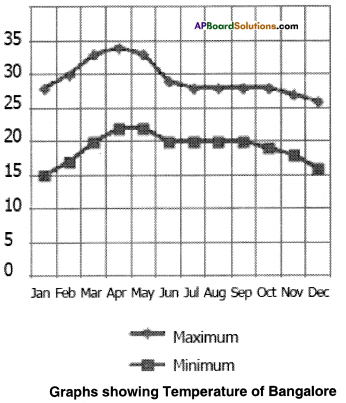 a) What is the average highest temperature in July?
a) What is the average highest temperature in July?
Answer:
28°C
b) How warm does it usually get in December?
Answer:
26°C
c) How cool does it usually get in June?
Answer:
20°C
d) Is there a bigger difference between night and day temperature in May or in August?
Answer:
In the month of May
e) When is summer?
Answer:
March, April and May months.

Question 10.
Nithin says thermal power is better to use, but Padmaja says that Solar Energy is better. Which of them do you support? Why?
(OR)
How is solar energy better than thermal power?
Answer:
Solar energy is better than thermal power because solar energy is clean, breath-takingly abundant and is a responsible renewable resource to meet much of the world’s energy needs, as well as a fundamental need of our body for vitamin D.
Question 11.
Read the para under the title “Height and Temperature” and comment on it.
At the peak of summer some people go from the plains to hilly places such as Ooty or Shimla to avoid the heat. Even in the summer months, the temperatures are low on high hills. The highest parts of a mountain generally have the lowest temperatures. Temperatures decreases with elevation (height).
Answer:
The temperature decreases with altitude. On an average, the temperature decreases by 3.5°F for every 1000 ft of altitude (6.5°C for every 1000 metres).
Additional information: The lapse rate depends on, if the air is dry or moist – in dry air, the temperature decreases more quickly, in moist air more slowly.
8th Class Social Studies 2nd Lesson Energy from the Sun InText Questions and Answers

Question 1.
Can you point out the difference between insolation and radiation? (Textbook Page No. 19)
Answer:
Insolation: The radiation received on the surface of a body is called insolation.
 Radiation: When a body gives out energy it is called radiation.
Radiation: When a body gives out energy it is called radiation.
Question 2.
What will happen if the atmosphere gets more polluted with smoke and duct? (Textbook Page No. 19)
Answer:
Some amount of solar rays are absorbed or reflected away by smoke or dust in the atmosphere. If the atmosphere gets more polluted with smoke and dust, it may absorb more heat. As a result the temperatures on the earth may raise. If it reflects more, there will not be heat on the earth. Both are dangerous to ‘the life’ on ‘the earth’.

Question 3.
Can you tell why there is difference in heating of land and water? (Textbook Page No. 21)
Answer:
The water is transparent and lets energy pass through. On the other land, the sun heats up only the top layer of the land. This is because the land is solid. A solid is opaque and does not let energy through. This is the difference in heating of land and water.
Question 4.
a) Where will the rays fall more slanting – in Japan or North Pole? (Textbook Page No. 20)
Answer:
In North pole.
b) Where will Sun’s rays fall more intensively, in Andhra Pradesh or Rajasthan?
Answer:
In Andhra Pradesh.
c) If the Earth is flat and not curved, then which will get more heat – Japan or the Equator, or both equally?
Answer:
Both equally,
d) Look at the globe and say which countries wifi be hotter and which will be cooler?
Answer:
- Australia, Indonesia, Philippines, Cambodia, India, Chile, Brazil, Sudan, Uganda, etc. -hotter.
- North America, Iceland, Scandinavia and Russia, etc. – cooler.
Question 5.
To get an idea of other temperatures, measure and note the temperature of the following things. Before you start measuring, guess the temperature of each one. (Textbook Page No. 23)
| Thing | Temperature, °C |
| Guess | Measurement |
| Water in bucket | | |
| Ice | | |
| Giass of cold water | | |
| Warm bath water | | |
Answer:
| Thing | Temperature, °C |
| Guess | Measurement |
| Water in bucket | 25°C | 35°C |
| Ice | 0°C | 0°C |
| Glass of cold water | 15°C | 10°C |
| Warm bath water | 70°C | 76°C |
Question 6.
It is safer and advisable to use thermometers that have a scale of -10°C to 110°C. Using such a thermometer, also measure and note the temperature of boiling water and hot tea. (Textbook Page No. 23)
Answer:
- Temperature of boiling water: 100°C
- Temperature of hot tea: 95°C,
Question 7.
Look at the number line below, you can see how + and – numbers are marked. (Textbook Page No. 24)

a) Which temperature is greater: 5°C or -5°C?
Answer:
5°C
b) At which of these two temperatures will we feel colder?
Answer:
-5°C
c) How many degrees difference is there between -5° and 5°?
Answer:
10°C
d) Write in short form each of the following temperatures:
i) 88 degrees below zero, Celsius
Answer:
-88°C
ii) 38 degrees above freezing, Celsius
Answer:
38°C
iii) 32 degrees below freezing, Celsius
Answer:
-32°C
e) Did you note the temperature in your classroom today? 88 degrees below zero Celsius is how many degrees lower than the temperature you measured?
Answer:
Classroom temperature = 28°C It is 116°C low.
f) The temperature of a normal human body is 37°C. How much hotter than normal body temperature is 50°C?
Answer:
13°C
g) How much colder than the normal body temperature is -5°C?
Answer:
42°C
h) Arrange the following temperatures from the highest to the lowest:
12°C, -16°C, 29°C, 0°C, – 4°C.
Answer:
29°C, 12°C, 0°C, -4°C – 16°C.
i) At which of the above temperatures will we feel hottest?
Answer:
At 29°C
j) At which of the above temperatures will we feel coldest?
Answer:
At -16°C.

Question 8.
Have you been to places that have different climate than where you live? Describe it in the class. (Textbook Page No. 18)
Answer:
I live in Vijayawada It is very hot place. I have been to Ooty during last vacation. It is a hill station in Tamilnadu. It is situated on Nilgiri hills. I went from Vijayawada to Coimbatore and there to Ooty. It is ‘queen of hill stations’. It is too cool as it is situated on high altitude. There I stayed in a hotel opposite to ‘Horse Race Course’. There I visited Dodabetta peak, Love Dale, Wildlife Sanctuary, Botanical Gardens, Emerald lake etc., in Ooty. There I enjoyed the cold in summer. I took a resolution on the 1st January of this year that I would visit Ooty often in my life. I love the memories of my trip.
Question 9.
Table 1: (Average monthly temperature of Ananthapuram)
| Month | Maximum,°C | Minimum, °C |
| Jan | 30 | 17 |
| Feb | 33 | 19 |
| Mar | 37 | 22 |
| Apr | 39 | 26 |
| May | 39 | 26 |
| Jun | 35 | 25 |
| Jul | 33 | 24 |
| Aug | 33 | 24 |
| Sep | 33 | 23 |
| Oct | 32 | 23 |
| Nov | 30 | 20 |
| Dec | 29 | 18 |
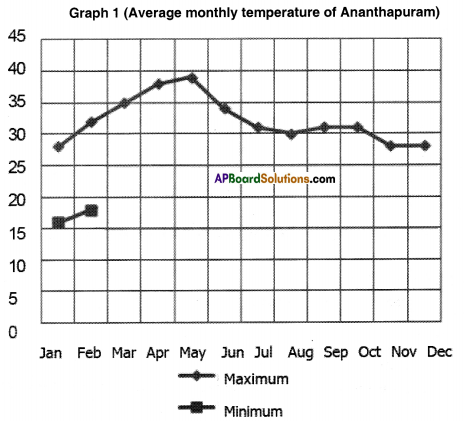
Use the data in the Table 1 and plot the average minimum monthly temperatures for Ananthapuram on the same graph paper in which the graph of maximum temperatures is drawn for your understanding. The first two months have already been done for you in the Graph 1.
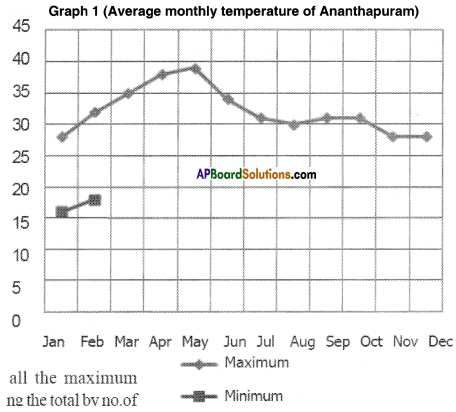
Look at the data and the graph and answer the following questions about Ananthapuram:
a) How cold does it usually get in November in Ananthapuram?
Answer:
20°C
b) Which month has the highest maximum temperature in Ananthapuram?
Answer:
April and May, 39°C
c) What is the difference between the highest maximum temperature and the lowest maximum temperature in the year?
Answer:
22°C.
d) Which three months are the hottest in Ananthapuram?
Answer:
March, April and May.
e) Which three months are the coldest?
Answer:
December, January and February
f) What is the average maximum temperature in January in Ananthapuram?
Answer:
30°C
g) From June through December, the average minimum monthly temperature keeps falling in Ananthapuram. Does the average maximum monthly temperature also keep falling?
Answer:
Yes, It is also falling.
h) What is the difference between the maximum and minimum temperature in May?
Answer:
13°C
i) What is the difference between the maximum and minimum temperature in August?
Answer:
9°C
j) Based on your answers to the above two questions, is there a larger difference between the maximum and minimum temperatures in the summer or in rainy season in Ananthapuram?
Answer:
There is not much variation.

Question 10.
Table 2: (Average monthly temperature)
| Month | Maximum,°C | Minimum, °C |
| Jan | 32 | 19 |
| Feb | 32 | 21 |
| Mar | 32 | 23 |
| Apr | 33 | 25 |
| May | 33 | 26 |
| Jun | 30 | 24 |
| Jul | 29 | 24 |
| Aug | 28 | 24 |
| Sep | 29 | 24 |
| Oct | 32 | 24 |
| Nov | 33 | 22 |
| Dec | 32 | 21 |
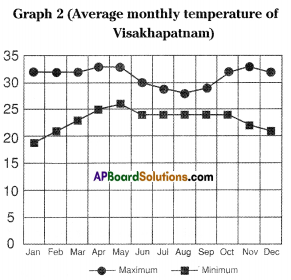
The average of maximum and minimum monthly temperatures are plotted on the Graph 2.
a) Which month has the lowest minimum temperature in Visakhapatnam? How much is it?
Answer:
In the month of January; It is 19°C.
b) Which is the hottest month in Visakhapatnam? How much was the average maximum temperature for that month?
Answer:
April, May and November months are too hot; 33°C.
c) Compare the temperatures of Ananthapuram and Visakhapatnam to answer the following:
i) In January, which place is colder?
Answer:
Ananthapuram
ii) In June, which place is hotter?
Answer:
Ananthapuram
iii) In which place, Ananthapuram and Visakhapatnam does the temperature remain more or less the same throughout the year?
Answer:
Visakhapatnam

Question 11.
Observe the following graphs.
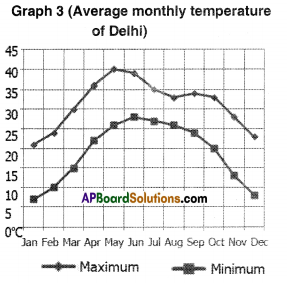
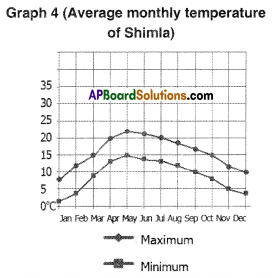
Now answer the following questions.
a) Can you think of any other reason for this state of temperature?
Answer:
Due to altitude, mean sea level, etc. the state of temperature differs.
b) What will happen if the inversion occurs?
Answer:
When inversion occurs cold air underlies warmer air.
c) How many metres higher than Delhi is Shimla?
Answer:
Shimla is 1900 metres higher than Delhi.
d) Based on the difference in elevation, calculate the likely difference in temperature between the two places.
Answer:
Approximately 12°C.
e) Which month has the highest maximum temperature in Shimla? How much is the temperature?
Answer:
May month, it is 22°C.
f) Which month has the highest maximum temperature in Deihi? How much is it?
Answer:
May month. It is 40°C.
g) In September, the average maximum temperature in Shimla is ———–°C while in Delhi, it is ———–°C.
Answer:
17°C, 34°C.
h) Which is colder: Delhi in January or Shimla in July?
Answer:
Delhi in January is colder.

Question 12.
Sometimes, especially in mornings of winters, coal temperatures are found near the ground. You can see dew drops on the grass due to condensation. The cooler temperatures near the ground level are due to less amount of insolation received due to the shorter days and excessive radiation due to the longer nights. This is known as inversion. (Textbook Page No. 28)
a) Can you think of any other reason for this state of temperature?
Answer:
I find no other reason.
b) What will happen if the inversion occurs?
Answer:
When inversion occurs cold air underlies warmer air.
Question 13.
Observe the following graph.
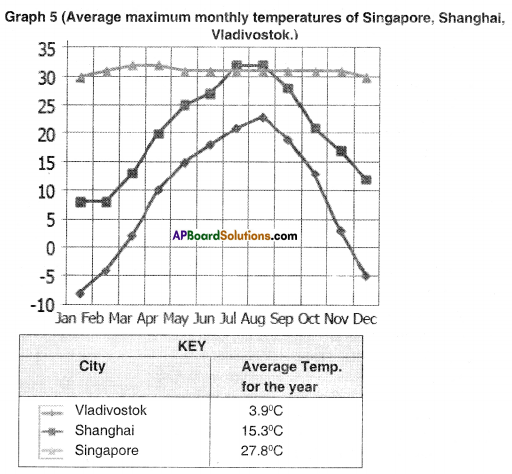
a) Which of the three places shown in the graph is located near to the Equator?
Answer:
Singapore
b) What is the average yearly temperature in that place?
Answer:
27.8°C
c) Does it usually get much warmer in the summer than in the winter there?
Answer:
No, there is slight difference.
d) Is summer in Vladivostok warmer than the winter in Singapore?
Answer:
No, there is much difference.
e) Does it usually get warmer in July in Singapore or in Shanghai?
Answer:
Singapore
f) Which of the three places on the graph has the most extreme climate?
Answer:
Vladivostok
g) What is the warmest month in Shanghai?
Answer:
July and August
h) What is the average yearly temperature there?
Answer:
15.3°C
i) Which month has the lowest average maximum temperature in this place?
Answer:
January and February.

Question 14.
Use the maps in your Atlas to find out the latitude and the average temperature in January of each of the following places: The first one has already been done for you.
| Place | Lat. | Temp, in January |
| Vijayawada, A.P. | 17° N | between 20 and 22.5° C |
| Agra, U.P. | | |
| Madurai, T.N | | |
| Nagpur, M.H | | |
a) According to this map, there is no place in India that has an average January temperature higher than 30°C. (Remember, this is the average. There may be some January days in some places that do get hotter than 30°C.)
Look at the map and find out which parts of India usually have the highest average temperature (in January).
b) If you look north from this place on the map, is the average January temperature higher or lower?
Answer:
| Place | Lat. | Temp, in January |
| Vijayawada, A.P. | 17°N | between 20 and 22.5° C |
| Agra, U.P. | 27°N | 22.3°C- 8°C |
| Madurai, T.N | 9.93°N | 30°C – 20°C |
| Nagpur, MH | 21 °N | 28°C – 12°C |
a) Southern parts of India have the highest average temperature.
b) It is lower.

Question 15.
Why is the North cooler in winter? (Textbook Page No. 30)
Look at the following table, it shows sunrise and sunset in different cities in India on 10th January.
| Place | Sunrise | Sunset |
| Visakhapatnam, A.P. | 6:29 | 5:38 |
| Agra, U.P. | 7:09 | 5:42 |
| Madurai, T.N. | 6:37 | 6:12 |
| Nagpur, MH | 6:53 | 5:48 |
| Hyderabad, T.S. | 6:49 | 5:58 |
| Kohima, Nagaland | 6:02 | 4:40 |
Answer the questions below:
a) In which of these six cities does the sun rise first?
Answer:
Kohima (Nagaland)
b) In which of these cities does the sun set last?
Answer:
Madurai.

Question 16.
Find out the locations of Singapore, Shanghai and Vladivostok on the following picture of the globe.
Answer:

Project work
Question 1.
You know that the Sun is the source of heat on the Earth. But why do you think the heat varies from morning to night or from season to season and from place to place? We are listing some variations here. Try to think a reason for it and discuss in the class before you proceed to read this chapter. (Textbook Page No. 18)
- Cool in the early morning and warmer in the afternoon.
- Warm in summer and cool in winter.
- Cool on hill tops and warm in the plains.
- Warm in Equatorial region and cold in Polar region.
Answer:
The heat on the earth varies from morning to night or from season to season and from place to place. The reasons are latitude, altitude, distance from the sea, ocean currents, mountain barriers, air masses and prevailing wind system.
Reason 1: In the morning the Sun’s rays are slanting on a particular place. In the afternoon they are straight on the same place. This is due to rotation.
Reason 2: During the summer the Sun’s rays hit the earth at a steep angle. The light does not spread out as much, thus increasing the amount of energy hitting any given spot. Also the long day light hours allow the earth plenty of time to reach warm temperatures. This is due to revolution.
Reason 3: The average rate of decrease of the temperature of normal air with the increase in height. It is equal to 6°C/km. (Normal Lapse Rate)
Reason 4: The Sun’s rays fall straight on the equatorial region and starting on the poles.
This is due to curvature of the earth.

Question 2.
Measure the temperature for a week in different months throughout the year. You will be able to see the temperature differences that occur between the summer, winter, monsoon, and other seasons. (Textbook Page No. 23)
a) For the next week, measure the air temperature each day at the same time and place (Remember to choose a place that Is in the shade). Each day before you measure, write down your guess. Keep your record in a separate notebook.
Place: ———–
Time: ———–
Month: ———–
| Date | Air Temperature, °C |
| Guess | Measurement |
| | |
| | |
| | |
| | |
| | |
| | |
| | |
b) Record the temperature every day for one week for few months.
c) Calculate the weekly average temperatures.
d) Discuss the variations between different weeks.
Answer:
Place: Bengaluru
Time: 12 Noon
Month: January
| Air Temperature, °C |
| Date | Guess | Measurement |
| 18.1.2016 | 28°C | 29°C |
| 19.1.2016 | 27°C | 30°C |
| 20.1.2016 | 29°C | 30°C |
| 21.1.2016 | 29°C | 30 C |
| 22.1.2016 | 28°C | 30°C |
| 23.1.2016 | 27°C | 30°C |
| 24.1.2016 | 28°C | 30°C |
![]()
![]()
![]()
![]()
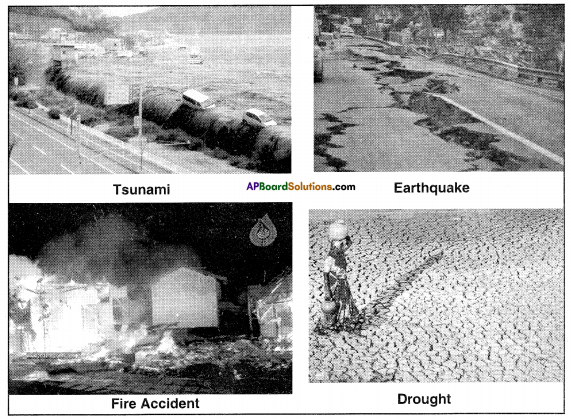
![]()


 a) What is the average highest temperature in July?
a) What is the average highest temperature in July? Radiation: When a body gives out energy it is called radiation.
Radiation: When a body gives out energy it is called radiation.









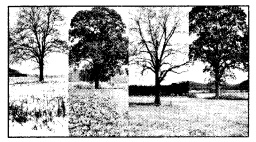
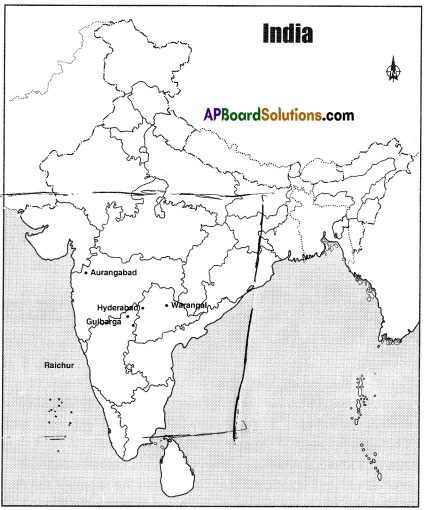
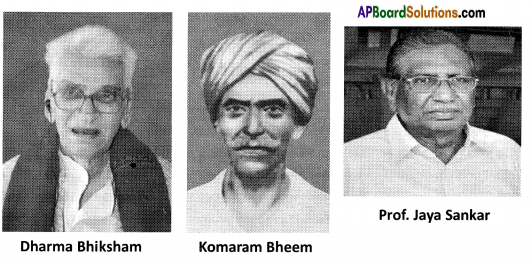


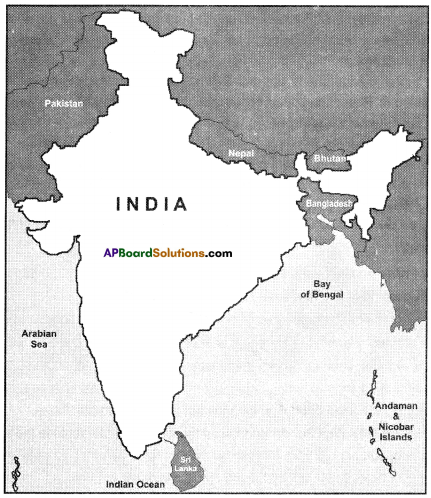 Both Pakistan and Bangladesh are our neighbouring countries.
Both Pakistan and Bangladesh are our neighbouring countries.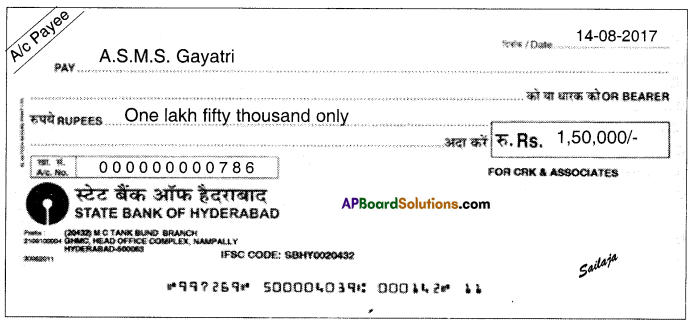
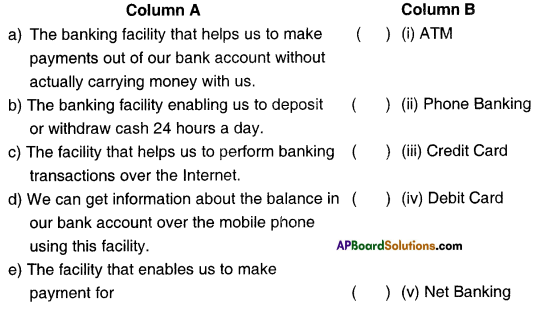

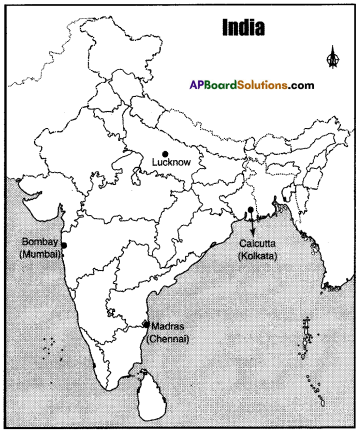

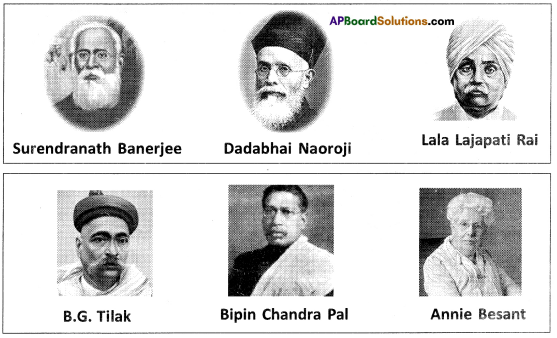 Answer:
Answer: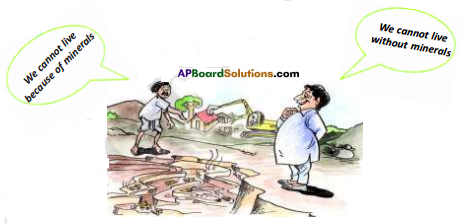 Answer:
Answer: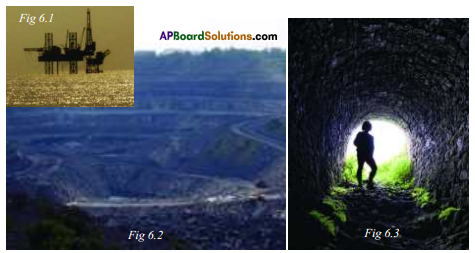

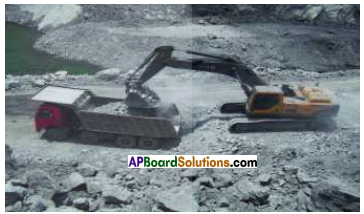
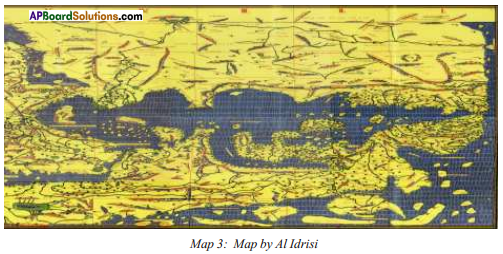 Note: To read this map we should turn it upside down.
Note: To read this map we should turn it upside down.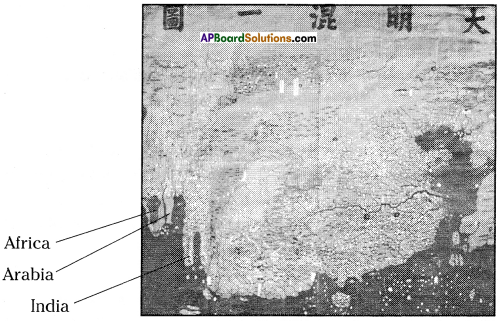 Answer:
Answer: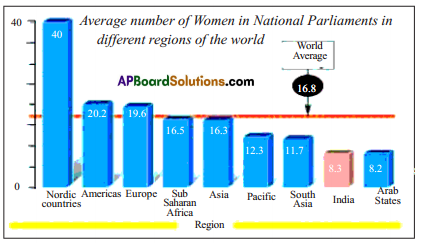 Based on the above information write an essay analysing the following aspects:
Based on the above information write an essay analysing the following aspects: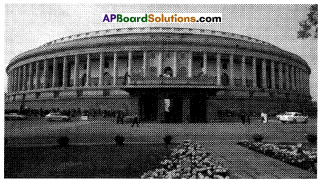
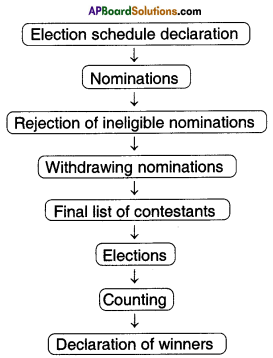
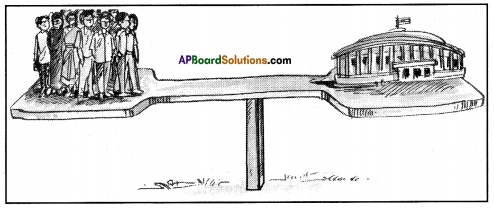 Answer:
Answer: